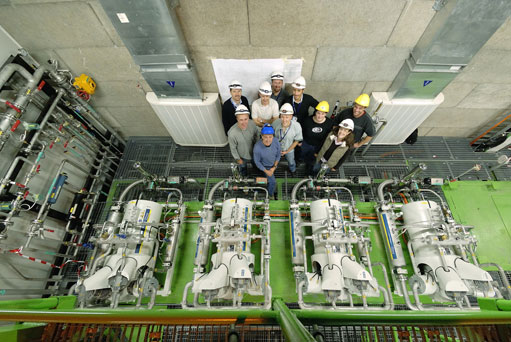
ATLAS e-News
23 February 2011
Return of the ID compressors
29 June 2009

Back in USA15?
The cooling compressors of the Inner Detector have been under much scrutiny since cracks appeared in some of their welds last summer – a critical failure in this system means no data from either of our silicon trackers. However, from all appearances in the first run of the refurbished compressors, the problem won’t be returning.
The cracks were caused by fatiguing the material – vibrations stressing the weld until it finally broke – after more than 100,000 cycles. The cooling – system had not attempted sustained running until May 2008, when the last of six compressors arrived, so the repetition-induced problem didn’t arise until early summer.
One troubled weld was a T-shaped junction, formed by cutting a hole in one pipe, fitting in another at a right angle, and sealing the pipes in place. In order to fortify this junction CERN suggested that Haug Kompressoren AG of St. Gallen, Switzerland, use a solid, T-shaped fitting – securing pipes to the three ends. The solid piece’s curved angles ease into the junction, making for a stronger structure than the sharp angles of the initial welded version. This fitting reduces stresses on the connection.
Ironically, the supports were another cause of stress, as they were directly attached to the pipes. Rather than preventing the vibrations, they compounded the strain on the welds, so Haug also changed their design. Now, plastic pieces, shaped to hug the pipes while still forgiving small movements, secure the system.
The compressors shipped out of CERN at the beginning of January, and the first refurbished model arrived at the end of February. This compressor was taken underground, to USA 15, and connected to the cooling system, bypassing the detector. There, it faced rigorous tests for vibration and also pulsation, propagating waves through the pipes. “We have verified that the stress levels are well under the limit,” says Michele Battistin, Section Leader of the EN/CV/Detector Cooling Section.
The pulsation tests were conducted under the leadership of Piotr Cyklis of the University of Krakow, an expert in compressor analysis. CERN’s Mechanical and Material Engineering group lead the vibration tests. Following their success, Haug received the “green light” to complete the refurbishments, delivering the first in early March. “We were able to really start the installation around May,” says Michele, “and in the meantime we had a large refurbishment of the distribution system in UX15.”
This undertaking placed pressure monitors on the out-going C3F8 liquid lines and incoming gas lines. “This is simple, not a problem at all,” says Michele, but he notes the challenge: there are 204 lines each, incoming and outgoing. The team completed all 408 modifications between mid-February and May.
The ID cooling system started up again on June 5th, running continuously until July 6th. So far, so good. “We detect some leaks in the system,” Michele admits, but tightening seals at the junctions has stopped the leaks so far. The team is on close watch for problems that repeat, or seem particularly susceptible to the vibrations.
At ambient cooling temperature of 20°C, only four compressors run at a time. But as the Inner Detector cools to running temperature, -25°C is needed in the cooling loop to reach -10°C on the modules themselves, so the drop in pressure will require six compressors to function simultaneously in order to keep the ID temperature low.
A seventh compressor is joining the original six, a backup in case of trouble. We hope that this precaution will prove unnecessary, given the detailed study of the problem and the carefully tested solution prepared through collaboration among our Inner Detector services team, the CERN engineers, and Haug.

Katie McAlpineATLAS e-News |